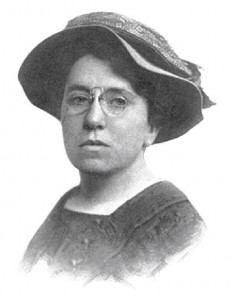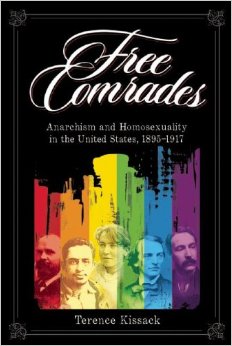 Free Comrades: Anarchism and Homosexuality in the United States, 1895-1917
Free Comrades: Anarchism and Homosexuality in the United States, 1895-1917
by Terence Kissack
AK Press. 220 pages, $17.95
THE COVER of Terence Kissack’s book depicts a rainbow flag overlaid with the portraits of Benjamin Tucker, Alexander Berkman, Emma Goldman, John William Lloyd, and Leonard Abbott—five important figures within the American anarchist movement during the early years of the 20th century. In this way, it encapsulates Kissack’s main thesis in Free Comrades. In his introduction, Kissack explains: “It is my hope that this book recovers and gives proper attention to the important role that anarchist sex radicals have played in the history of the Left and in the history of the politics of homosexuality.”
The book’s title itself refers to the journal The Free Comrade, which was edited by John William Lloyd with the help of Abbott in the early 20th century. Kissack insists at several points in his analysis that the anarchist sex radicals were not necessarily gay but rather, by applying the fundamental tenets of anarchy to the sexual question, they fought on the side of any oppressed group: “Anarchism was the only political movement of the time to treat issues of sexual liberation as fundamental to the project of human emancipation.” The study is divided into six thematic chapters plus a short introduction and a conclusion.
At the outset, Kissack lays the ground for his study by sketching the context in which to understand the American anarchist movement at the turn of the century and the use of the word “homosexual,” a term that wasn’t coined until 1869 by Hungarian sexologist Karoly Maria Kertbeny. In the second chapter, Kissack tackles the trials of Oscar Wilde in 1895. Given the anarchists’ defense of the right of all individuals to pursue their lives without interference from any type of authority—whether political, social, or cultural—it comes as no surprise that they championed Oscar Wilde’s cause. In fact, Kissack convincingly argues that by exposing the dangers of state intervention into the private sexual lives of its citizens, the Wilde case served as the catalyst for a symbiosis between anarchist politics and gay rights. During his travails, the anarchists helped Wilde by publishing his works and writing tracts in his defense. The role of Benjamin Tucker was nothing short of heroic. For instance, he published Wilde’s Ballad of Reading Gaol when no other American publisher would do so. He also wrote scathing criticisms of the British courts for Wilde’s condemnation, exposing their hypocrisy: “The imprisonment of Wilde is an outrage that shows how thoroughly the doctrine of liberty is misconceived.”
Addressing Walt Whitman’s poetry and its reception in anarchist circles, Kissack reminds us that the sale of Leaves of Grass was actually forbidden in Boston in 1882. Once again it was Benjamin Tucker who fought against this injustice by promoting the book against the authorities’ mandates.

At first, the homoerotic undertones of Whitman’s work were kept within the discourse of “normal” homosocial bonding. Later, it acquired a more “suspicious” sexual charge. Kissack situates Whitman at the dawn of a new conception of the homosexual, that of a psychologically determined type of person. To illustrate this shift, Kissack uses John William Lloyd’s own ambiguous relationship to Whitman. While Lloyd championed Whitman’s poetry within the homosocial paradigm, he quickly distanced himself from it once it became associated with homosexual eroticism.
A chapter titled “Love’s Dungeon Flower: Prison and the Politics of Homosexuality” presents a reading of Alexander Berkman’s Prison Memoirs of an Anarchist, which was published in 1912. Berkman was sentenced to fourteen years in prison for the attempted assassination of Henry Clay Frick, who worked with the industrial magnate Andrew Carnegie. The salacious details of same-sex relations behind bars assured the notoriety of these memoirs. Kissack distinguishes between two types of relationships that, according to Berkman, flourished in prison: one driven by a power differential and another based on mutual love. For instance, the culture of “kid men” and “punks”—“submissive sexual partner of an older tramp or a prison inmate”—exemplified the hierarchical models. On the other hand, there were the more egalitarian relationships, such as the ones he himself experienced with two inmates, Russell and Felipe. Berkman champions these illicit relations as “a form of resistance to the spirit-crushing environment of prison.” By offering a positive model of homosexual love, Berkman thus opened the way to a reinterpretation of same-sex desire outside of its criminal, hierarchical associations. It is ironic, however, that such relationships would thrive in prison, the place where homosexuals were often sent as punishment for their offense.
The anarchists’ embrace of the nascent science of sexology is an interesting sidelight to their habit of questioning authority, whether moral or political. The figure of Emma Goldman is a case in point. She cultivated ties with several European sexologists, such as Edward Carpenter, Havelock Ellis, and Magnus Hirschfeld. In fact, Goldman delivered a series of lectures in 1915 and 1916 in defense of homosexuality using research from these scientists. She was arrested before giving a lecture in Portland, Oregon, where a scandalous raid at the YMCA in 1912 brought “to public attention the existence of a lively cruising scene.” Who would have known that this tradition had existed for so long?
By the time we reach World War I, the anarchist movement is already in retreat. During the Great War, the government passed a series of stringent laws that curtailed civil liberties, such as the Espionage Act of 1917 and the Sedition Act and the Anti-Anarchist Act of 1918. Anarchist leaders such as Emma Goldman and Alexander Berkman were sent to prison and later deported. After the War, anarchism was eclipsed by communism as the dominant leftist ideology, and the fight for homosexual rights receded into memory.
While anarchism seems to have come out of the shadows to inform the countercultural movements of the 1960’s and 70’s, Kissack highlights their differences: “I wish to point out that the culture, ideas, social basis, rhetoric, and style of anarchism that exists today is quite different than that which flourished in the United States in the decades prior to WWI.” This difference extends to the realm of GLBT rights. For instance, modern-day demands for same-sex marriage are at odds with a central goal of the anarchist sex radicals, who wanted to dismantle marriage as an institution that legalized gender disparities and brought the state into the private lives of individuals. The anarchists’ vision was a sexual utopia in which relationships would no longer be defined by differences of power or fixed gender roles. Thanks to Terence Kissack’s straightforward account, the memory of these anarchists and their efforts has been rehabilitated, adding an important chapter to the continuing struggle for GLBT equality, itself an aspect of the larger goal of human emancipation.
Eduardo Febles is an assistant professor in the Modern Languages Dept. of Simmons College.






